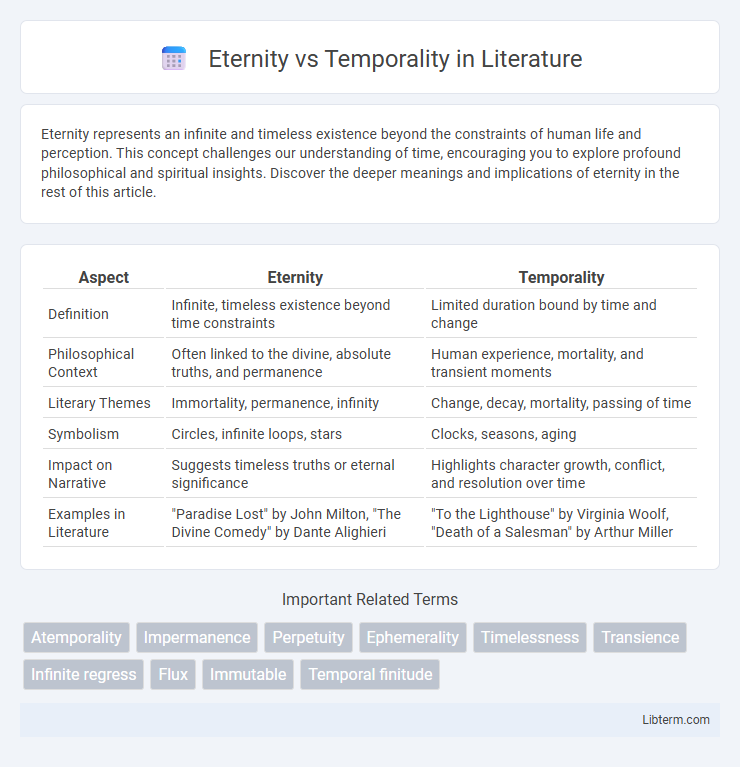Eternity represents an infinite and timeless existence beyond the constraints of human life and perception. This concept challenges our understanding of time, encouraging you to explore profound philosophical and spiritual insights. Discover the deeper meanings and implications of eternity in the rest of this article.
Table of Comparison
| Aspect | Eternity | Temporality |
|---|---|---|
| Definition | Infinite, timeless existence beyond time constraints | Limited duration bound by time and change |
| Philosophical Context | Often linked to the divine, absolute truths, and permanence | Human experience, mortality, and transient moments |
| Literary Themes | Immortality, permanence, infinity | Change, decay, mortality, passing of time |
| Symbolism | Circles, infinite loops, stars | Clocks, seasons, aging |
| Impact on Narrative | Suggests timeless truths or eternal significance | Highlights character growth, conflict, and resolution over time |
| Examples in Literature | "Paradise Lost" by John Milton, "The Divine Comedy" by Dante Alighieri | "To the Lighthouse" by Virginia Woolf, "Death of a Salesman" by Arthur Miller |
Understanding Eternity and Temporality
Eternity refers to the concept of infinite or timeless existence beyond the constraints of beginning and end, often associated with philosophical and theological interpretations of unchanging reality. Temporality, by contrast, denotes the condition of existing within time, characterized by change, progression, and finite duration. Understanding eternity involves grasping the nature of existence beyond time, while understanding temporality entails recognizing the transient, evolving nature of life and events within the temporal framework.
Philosophical Foundations of Eternity
Eternity, in philosophical terms, is often conceptualized as a timeless, infinite state beyond the constraints of temporal succession, central to metaphysical discussions by thinkers like Plato and Augustine. The philosophical foundations of eternity involve the notion of an unchanging, immutable reality that exists outside the flow of past, present, and future, challenging temporal human experience. This contrasts sharply with temporality, which defines existence as subject to change, decay, and finite duration within time's linear progression.
The Nature of Temporal Existence
Temporal existence is defined by its transient and finite nature, governed by the continuous flow of past, present, and future. In contrast, eternity embodies a permanent, unchanging state outside of time's linear progression. This distinction underscores the fundamental difference between impermanence in temporal life and the timeless permanence of eternal existence.
Religion’s Perspective on Eternity vs Temporality
Religious doctrines often depict eternity as an infinite, timeless state where the soul experiences unending communion with the divine, contrasting temporality, which is marked by transient earthly life and finite experiences. In Christianity, eternity is associated with eternal life granted by faith in God, while temporality relates to the mortal journey and moral testing on earth. Hinduism views temporality through the cycles of samsara (rebirth), with liberation (moksha) representing eternal freedom beyond temporal suffering.
Scientific Views on Time and Permanence
Scientific views on time differentiate between eternity as an unchanging, infinite continuum and temporality as the measurable progression of events within spacetime. Physics, particularly through Einstein's theory of relativity, describes time as a dimension intertwined with space, where time's passage is relative and dependent on the observer's frame of reference. Quantum mechanics challenges classical notions of permanence by introducing probabilistic states, suggesting that permanence is an emergent property rather than an absolute reality.
Human Experience: Living in the Present or Seeking the Eternal
Human experience constantly navigates between eternity and temporality, balancing the immediacy of living in the present with the quest for eternal meaning beyond transient moments. Embracing temporality shapes awareness of life's fleeting nature, urging mindfulness and appreciation of the here and now. Seeking the eternal motivates individuals to find enduring purpose, spiritual fulfillment, or legacy that transcends time's limits.
Literature and Art: Expressions of the Eternal and the Temporal
Literature and art often explore the tension between eternity and temporality by depicting eternal themes such as love, death, and divinity alongside transient human experiences and fleeting moments. Classic works like Dante's "Divine Comedy" symbolically bridge the temporal world and the eternal realm, while Romantic poetry captures the ephemeral beauty of life. Visual arts, from Renaissance frescoes to contemporary installations, use symbolism and temporal motifs to express the interplay between the everlasting and the momentary, highlighting humanity's quest for meaning beyond time.
Ethical Implications: Decision-Making in a Temporal World
Ethical decision-making in a temporal world demands balancing short-term consequences with long-term values, highlighting the tension between temporality and eternity. Temporal ethics often prioritize immediate outcomes and societal norms, while an eternal perspective encourages adherence to enduring moral principles beyond fleeting circumstances. Understanding this dynamic aids in developing responsible frameworks that account for both present realities and timeless ethical considerations.
Legacy and Memory: Bridging the Eternal and the Ephemeral
Legacy preserves human achievements and values, creating a bridge between eternity and temporality by embedding transient actions into lasting memory. Cultural artifacts, written records, and oral traditions serve as vessels that transmit identity and meaning across generations, extending influence beyond an individual's lifetime. Memory functions as a dynamic interface where ephemeral experiences gain significance, enabling individuals and societies to connect with a timeless continuum.
Toward a Harmonious View: Integrating Eternity and Temporality
Integrating eternity and temporality fosters a harmonious worldview where timeless truths coexist with the dynamic flow of experience, enriching both spiritual insight and practical living. Recognizing eternity as a constant dimension illuminates the transient nature of worldly events, allowing individuals to navigate change with deeper meaning and purpose. This synthesis encourages a balanced perspective, blending eternal principles with temporal realities to cultivate resilience, wisdom, and holistic understanding.
Eternity Infographic

 libterm.com
libterm.com